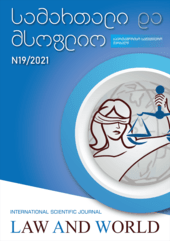Problems Related to Adoption Secrecy in Civil Law 
##plugins.themes.bootstrap3.article.main##
Abstract
The Institution of Adoption has ancient historical roots, its regulations have evolved and changed over the years. The process of Adoption, by its nature, is closely connected with the protection of the rights of children. In international agreements and treaties, it is evident that child should and must be raised up in a family, take into consideration their interests. Protection of child"s interests is as much important case for our country as well. In order to have a deep understanding of adoption process it is indispensable to determine what is adoption and its peculiarities, to separate it from neighboring institutions, determine legal statues of the subjects of legal relationship, learn in depth the problems related with the issues of confidentiality, procedural norms and the ways of adoption termination process. A number of changes have been adopted on the legislative level, the composition of norms has changes, court proceedings of adoption and rules of protecting confidentiality have been established. However, problem can still be seen, because of which adoption process often takes place through avoiding laws. It is necessary for the state to take the best interests of the child into account in practice as well. At the same time, the secrecy of adoption is protected by European standards within the framework of the right to respect for private life, so the general rules protecting the private sphere apply to it. In this regard, in addition to material and procedural norms, special importance is attached to international treaties and the sharing of European practices. This will help to prevent harsh violations of the rights and freedoms of children and will encourage effective protection of adopted individual"s rights.
##plugins.themes.bootstrap3.article.details##
Section
Articles
How to Cite
Problems Related to Adoption Secrecy in Civil Law. (2021). Law and World, 7(19), 184-198. https://doi.org/10.36475/7.4.8
How to Cite
Problems Related to Adoption Secrecy in Civil Law. (2021). Law and World, 7(19), 184-198. https://doi.org/10.36475/7.4.8


